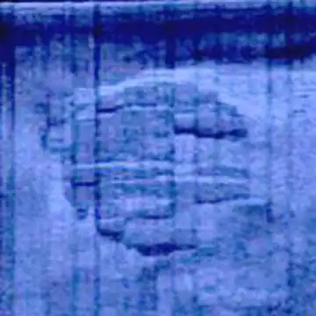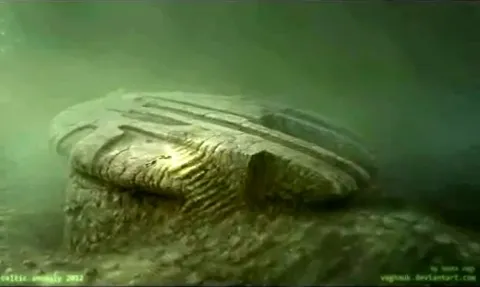“It’s sad, one minute you’re making the Kessel Run in less than twelve parsecs, the next you’re at the bottom of the Baltic Sea.” This YouTube comment about a hyperspace Star Wars route made me laugh, and it succinctly sums up how people felt about an enigmatic sonar image that took the internet by storm in 2011. The grainy image of a broken circular structure at the bottom of the Baltic Sea resembled the Millennium Falcon from Star Wars, but what was it really?
Background
Peter Lindberg, Dennis Asberg, and their OceanX team first detected the Baltic Sea anomaly while hunting for treasure in the summer of 2011. The team was searching the Gulf of Bothnia, the northernmost section of the Baltic Sea, for shipwrecks when suddenly, their sonar showed a formation that stood out because of its symmetrical circular appearance.
The images revealed an unusual, possibly artificial shape, prompting comparisons to UFOs, a sunken city, the Millennium Falcon, and a massive piece of machinery.

Sonar image of the Baltic Sea anomaly. Photo: OceanX
The hunt
Curiosity piqued, the team spent the next several months planning a second expedition with extra equipment and divers.
At first, they struggled to find the anomaly again. They launched several machines into the water, including remotely operated vehicles (ROVs) and cameras, to try and zero in on the anomaly’s location.
Lindberg swore his team to secrecy, believing that the anomaly might draw the interest of nearby nation-states. They took the necessary precautions: turned off cell phones, GPS, radios, and anything else that could be tracked. However, they were not able to stay incognito for long.
The team was startled when an ominous-looking black ship arrived. It was a Swedish military vessel, but it made no effort to communicate. According to Lindberg, the Swedish military had no business there because the expedition was in international waters. Nevertheless, the team continued their work, and the military vessel eventually left.
Soon after, the team detected a strange signal.
We turned off all instruments, and everyone on board turned off their cellphones. Then we found a signal, 40 megahertz strong, coming from nearby. But the nearest land, a lighthouse, where you might find such a signal, is 20 nautical miles (37km) away. And our equipment can only measure two, maybe three, kilometers away.
The expedition spent a day looking for the site by sonar, but their equipment mysteriously started to malfunction.

Artist’s impression of the structure. Photo: Hauke Vagt
After searching for several hours with frustrated crew members trying to get the equipment back online, they finally found the anomaly.
What did they find?
Two divers braved the cold, murky waters. They descended 90 meters without incident and were stunned by the size of the object. It measured 60 meters wide, 210 meters long, and 4 meters tall. Ridges and symmetrical lines covered its flat surface, and it had straight edges with some sections bearing sharp right angles.
The diving team dusted sediment from the object and found that the surface was black. One diver said it looked burnt. Here is a picture from the OceanX website:

Image taken from the Baltic Sea anomaly. Photo: OceanX
“If you look at the picture, you see a triangle with a hole. Hard to see, so I have a picture with a red line as well,” Lindberg said. “You can see that the plate is covered with sediment as well, and below, you see burnt organic material. The picture was taken on the side of the object.”
The footage from the dive also shows rings of rocks that appear to have been arranged. “Fairy circles?” one of the team members suggested.
The divers collected a couple of black stones from the structure. When the team delivered the rock samples to geologist Volker Bruchert at Stockholm University, he believed that the rock was likely volcanic.
Of volcanic origin?
The Baltic Sea does not have volcanic activity. Compared to most seas, it is relatively young, only 8,000 years old. The most significant event in the formation of the Baltic Sea was the Ice Ages. During these periods, massive ice sheets covered much of Northern Europe, including the area that would become the Baltic Sea.
As the glaciers advanced and retreated, they repeatedly carved up the region. When they finally melted around 10,000 years ago, lifting the tremendous weight of the ice from the land, it began to rise from post-glacial rebound. This continued for thousands of years, causing the shorelines of the Baltic to shift. The melting glaciers helped fill the basin with water, forming the sea we know today.
One way to explain volcanic rock is that glaciers carried the rock down to the sea. However, the sonar images show straight edges, which makes this unlikely. However, volcanic rock can occur on the surface or underwater, and the Baltic Sea does occasionally experience earthquakes. It is possible that earthquakes caused the rock to fracture at right angles and that erosion from ocean currents could have further shaped it.
Glacial deposit?
As glaciers move, they pick up rocks, dirt, and other debris from the landscape. When the glacier melts or retreats, it deposits this material in various forms. The Baltic Sea is of glacial origin, and the team detected a temperature drop just above the object’s surface, so this could make sense.
Could humans be responsible?
Underwater archaeologist Andreas Olsson believes the object is man-made. For Olsson, the object appeared cut or molded. This theory is not so far-fetched. In 2024, archaeologists discovered Europe’s oldest man-made megastructure in the Bay of Mecklenburg in the Baltic Sea. This megastructure was a kilometer-long wall of 1,500 granite stones submerged at a depth of 21 meters. Supposedly, a Palaeolithic community built it approximately 11,000 years ago.
A hoax?
Tabloids and internet trolls have not been kind to OceanX. A scathing blog post from 2019 suggested that Lindberg was letting his imagination run wild or pursuing his own opportunistic agenda. To me, this does not seem the case. OceanX has a solid reputation, state-of-the-art equipment, and seasoned professionals running its expeditions for over two decades. The shipwrecks they have found earned them the respect of the shipwreck-hunting community.
OceanX’s specialty is finding shipwrecks in the Baltic Sea. They have discovered wrecks ranging in age from the 1600s to World War I. One of their most famous discoveries was the wreck of the “Travelling Man” (or Reesande Mannen), a warship from the 1600s that carried a golden chariot, 60,000 ducats, silver, and jewels in its cargo.
They also discovered a Swedish steamer off the Aland Islands with over 1,000 bottles of cognac from 1917. They found three other wrecks dating back to the Russian Revolution, from which they salvaged a few thousand bottles of champagne as well as three Fabergé eggs worth a total of $84 million. It seems unlikely they’d risk their reputation on something they didn’t believe in.
Conclusion
The world should not be so quick to give up on the Baltic Sea anomaly. There is much we still don’t know, and further dives might clear up some of the many questions.






